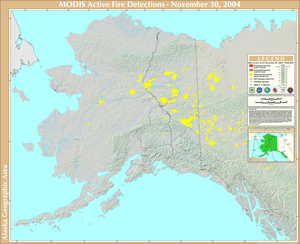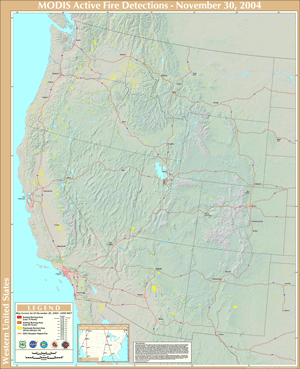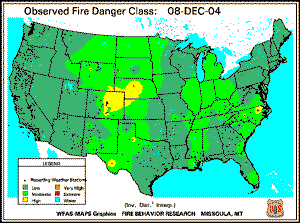According to the National Interagency Fire Center (NIFC), wildland fires in 2004 had consumed over 8 million acres across the U.S. as of early December, which was well above the 10–year average of over 5.5 million acres. By far the majority of this year's fire activity in the U.S. occurred in Alaska, which had over 6.6 million acres consumed across the state this year, making the 2004 fire season the worst on record for Alaska for acreage burned. Extensive fire activity also occurred in the adjacent Yukon territory of Canada, where over 1.8 million hectares (over 4.5 million acres) had burned as of the end of September (as reported by the Canadian Interagency Forest Fire Center-CIFFC). Across the contiguous U.S., the fire season was well–below average with just over 1.4 million acres burned in 2004.
Fire activity dimished significantly during the fall, with only a few large fires reported during November. By the end of November there were no large fires reported to the National Interagency Coordination Center (NICC), and only minimal small fire activity was reported across the entire country.
Dead fuel moisture levels improved significantly during November, as a series of fall storms moved across the western U.S. Significant snowfall was measured in the Sierra Nevada, Wasatch and the southern and central Rocky Mountains, bringing snow pack in the western U.S. to above normal in many locations based on snow water equivalent measurements at snotel sites.
| As of December 3, 2004 | Nationwide Number of Fires | Nationwide Number of Acres Burned |
|---|---|---|
| 2004 | 64,488 | 8,077,514 |
| 2003 | 63,629 | 3,960,842 |
| 2002 | 73,457 | 7,184,712 |
| Ten–year Average (1995–2004) | 74,485 | 5,531,387 |
These Pacific storm systems in late October and November brought well–needed relief to the long–term drought conditions in the Great Basin and southwestern U.S. By early December, the moisture conditions of fine–fuels (i.e. 10–hour fuels) were much improved across the Great Basin and southwestern states. However, moderate to severe drought conditions remained over portions of the Northern Rockies, mainly in Montana and Wyoming, and fine–fuel moisture remained very dry across the Front Range region in Colorado, as well as the high plains of Nebraska and Kansas.
Medium to larger fuels (i.e. 100–hr and 1000–hr fuels) had improved significantly across most of the western U.S. in November. The moisture content of 1000–hr fuels were above 15% over a broad region of the West, with parts of Nevada, California, Oregon, Washington, and Idaho exceeding 30%.
By early December, fire danger classification remained high in only a few areas, primarily in northeastern Colorado and western Nebraska.
 NOAA's National Centers for Environmental Information
NOAA's National Centers for Environmental Information


